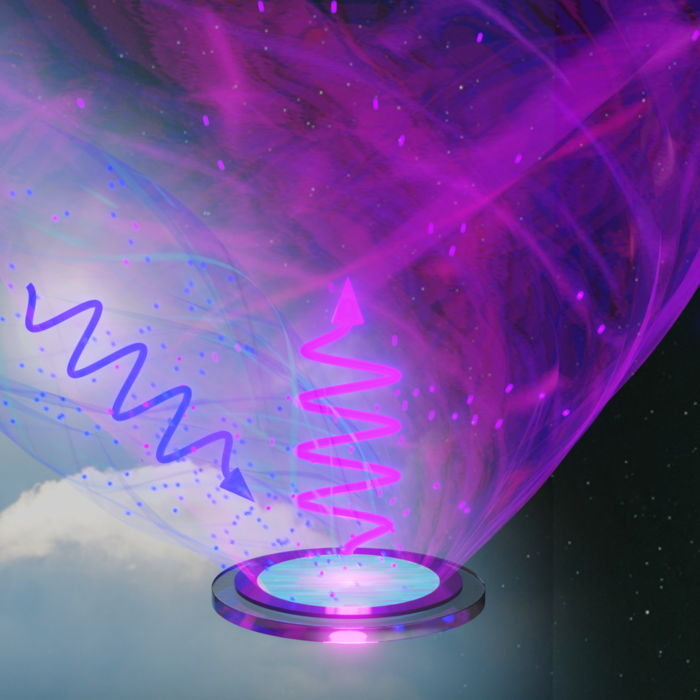Solar energy is a source of renewable energy. Sunlight is a high-energy UV light with a wavelength shorter than 400 nm, which has a variety of applications. For instance, for photopolymerization to create resin and photocatalyst activation to drive processes that generate green hydrogen or valuable hydrocarbons (fuels, sugars, olefins, etc.). “Artificial photosynthesis” is a term that is frequently used to describe the latter.

Image Credit: Prof. Yoichi Murakami
Another crucial usage is the photocatalytic reaction induced by UV light, which effectively destroys germs and viruses.
The UV part of the electromagnetic spectrum only makes up approximately 4% of terrestrial sunlight, which is unfortunate. As a result, a significant portion of the solar spectrum is not being used for these purposes.
Photon upconversion (UC) could provide the solution to this issue. It is the process of “triplet-triplet annihilation” (TTA), which transforms long-wavelength, low-energy photons (like those present in visible light) into short-wavelength, high-energy photons (like those present in UV light).
Previous studies in this field have documented visible-to-UV UC utilizing organic solvent solutions; however, to prevent oxygen exposure from degrading and deactivating TTA-based photon UC samples, the solution has to first be deoxygenated before being packed in an airtight container.
These materials not only lacked photostability in the presence of oxygen but also failed to function well when exposed to incoming light with the brightness of the sun. These problems created obstacles to photon UC’s practical usage.
Professor Yoichi Murakami and Mr. Riku Enomoto, a graduate student at Tokyo Tech, have now found a solution to these issues in the form of a groundbreaking solid film that performs visible-to-UV photon UC for weak incident light while being photostable for an unmatched length of time in the air. In their study published in the Journal of Materials Chemistry C, they detail their revolutionary idea.
Our invention will enable the practical utilization of the visible part of low-intensity light, such as sunlight and LED room light, for applications that are effectively done with UV light. And its photostability—demonstrated to be at least over 100 hours, even in the presence of air—is the highest ever reported in any TTA-based photon UC material, regardless of the material form, as long as we could survey.
Yoichi Murakami, Professor, Laboratory for Zero-Carbon Energy, Institute of Innovative Research, Tokyo Institute of Technology
These films also had a record-breaking excitation threshold (only 0.3× the sun’s intensity) and a high UC quantum yield of 4.3% (normalized UC emission efficiency of 8.6%) both in the presence of air, making them a unique material because most materials in this class lose their photon UC ability when exposed to air.
The researchers chose a combination of a sensitizer and an annihilator, which they then melted together to create the material. The sensitizer is a molecular chromophore that can absorb longer-wavelength photons; the annihilator is an organic molecule that receives the triplet excited energy from the sensitizer and then triggers the TTA process.
After cooling this bi-component melt across a surface with a controlled temperature gradient, a solid-state visible-to-UV photon UC thin film was created. Temperature gradient solidification is a unique method that is extremely repeatable and controlled, making it appropriate for use with actual industrial processes.
Prof. Murakami added, “We believe that the temperature-controlled solidification can provide a solid groundwork for developing advanced photon UC films, that too on a solid substrate without using organic solvents, as demonstrated for the first time by this work.”
Finally, the researchers used the thin film to cure and solidify a resin that would normally require UV light for the same process, demonstrating the visible-to-UV photon UC of the system by using a 1-Sun-intensity simulated sunlight consisting only of visible light.
The study introduced a unique class of UC solids with remarkable photostability in a practical style that can be utilized to upconvert low-intensity visible light photons into UV light photons when there is air present.
Prof. Murakami concluded, “Our research will not only expand the exploration of a new class of UV-light-generating materials but will also help in substantially broadening the utility of the abundant weak visible light towards applications that are driven by UV light.”
Journal Reference:
Enomoto, R., et al. (2023) Solvent-free temperature gradient melt formation of efficient visible-to-UV photon upconversion organic films with subsolar threshold and over 100 h photostability in air. Journal of Materials Chemistry C. doi:10.1039/D2TC04578H.